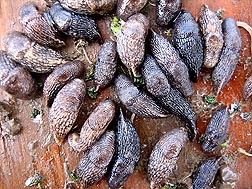Foraging Worms Guarantee Slug Bait Failure
|
|
Grey field slugs in the Pacific Northwest used to be kept in check by practices such as conventional tilling and burning postharvest straw residues. But many producers are now using no-till management and leaving leftover straw on the fields to enhance soil quality and prevent erosion. The downside to these sustainable practices is that they create a much more hospitable environment for slugs, which have become an agronomic nightmare.
“They’ll eat anything,” says Agricultural Research Service agronomist George Mueller-Warrant. “In the middle of the night, the ground is covered with them.”
These nocturnal mollusks, Deroceras reticulatum, are such pests that in western Oregon, producers of grass seed, wheat, and other field crops spend around $3.7 million every year for around 2.9 million pounds of slug bait. The bait is often in the form of metaldehyde—either as pellets, granules, or liquid—or iron phosphate pellets.
However, earthworms have also flourished under the no-till, no-burn agricultural regime. Foraging at night, they regularly make a meal of the slug bait with no apparent ill effects.
So Mueller-Warrant worked with ARS plant physiologist Steve Griffith and research leader Gary Banowetz to determine how much—and how quickly—slug bait was being lost to worms. All three scientists work in the ARS Forage Seed and Cereal Research Unit in Corvallis, Oregon.
The researchers treated 15 grass seed production fields and greenhouses with different types of slug bait and then spent 4 hours every night observing the foraging behavior of the worms. Averaged over all observations, half of the bait pellets disappeared in less than 2½ days.
The worms approached bait pellets the same way they approached all other potential food sources, and 20 percent of the time they ate them on the spot. But they usually took the pellets back into their burrows, sometimes at the rate of 3 every hour. The scientists noted that the worms strongly preferred the metaldehyde or iron pellets to other forms of the bait (liquid or granular).
The research team also surveyed earthworm populations but did not find any significant correlation between population density and rate of bait disappearance: At all observation sites, all of the bait disappeared by 7 or 8 days after it had been applied. The team’s calculations indicated that earthworm population densities everywhere were more than sufficient to remove all slug bait.
Oregon producers currently apply around 10 pounds of slug bait per acre 2 to 5 times a year to more than 185,000 acres of grass seed fields. But since much of the bait in the less-expensive pellet form is quickly consumed by worms, the scientists suggest that in fields of high-value crops, it might be more cost effective to apply fewer rounds of the more expensive granular and liquid bait, which the worms typically ignore.—By Ann Perry, Agricultural Research Service Information Staff.
This research is part of Agricultural System Competitiveness and Sustainability, an ARS national program (#216) described at www.nps.ars.usda.gov.
George Mueller-Warrant is with the USDA-ARS Forage Seed and Cereal Research Unit, 3450 S.W. Campus Way, Corvallis, OR 97331-8539; (541) 738-4130.
"Foraging Worms Guarantee Slug Bait Failure" was published in the May/June 2014 issue of Agricultural Research magazine.







